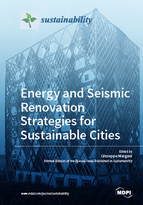Energy and Seismic Renovation Strategies for Sustainable Cities
A special issue of Sustainability (ISSN 2071-1050). This special issue belongs to the section "Energy Sustainability".
Deadline for manuscript submissions: closed (30 September 2018) | Viewed by 54842
Special Issue Editor
Interests: sustainable architecture; building technology; heritage conservation; architectural history; building renovation
Special Issues, Collections and Topics in MDPI journals
Special Issue Information
Dear Colleagues,
The principle of sustainability should be strictly connected with safety, since both aim to conserve resources: In the case of sustainability, those resources are typically thought of as environmental, while in the case of safety, the resources are basically human. In spite of this common ground, discussions of sustainability usually give insufficient attention to safety.
In seismic states like Italy, over 75% of the building stock is both highly earthquake-prone and energy-consuming.
In the last years the EU has made large investments to increase the energy efficiency of the existing real estate, paving the way for a low-carbon future. However, less effort has been made for reducing its seismic vulnerability. Therefore, the safety, and consequently the sustainability, of towns situated in seismic countries remains inadequate. In this sense, the disastrous effects of the earthquakes that have recently struck central Italy are emblematic.
In such countries, energy renovation actions should be combined with seismic retrofitting, for the following main reasons: Energy renovation alone will turn out to be worthless if an earthquake destroys the building; to avoid several costs otherwise duplicated (e.g., costs for building-site setup and scaffolds, cladding, plasters and other finishing); for preventing life losses and damages.
However, a number of barriers considerably limit the real possibility to extensively undertake combined retrofit actions, especially for multi-owner housing and high-rise buildings. These barriers are of different kinds: (i) technical (e.g. unfeasibility and/or ineffectiveness of conventional retrofit solutions, need of regulatory simplification); (ii) financial (e.g. high renovation costs, split-incentive/landlord-tenant dilemma, insufficient incentives and subsidies); (iii) organizational (e.g., temporary alternate accommodation for occupants, consensus to the retrofit expenditure by condominium ownerships, excessive time for getting construction permits); and (iv) cultural/social (insufficient information and skills, lack of adequate policy measures for promoting renovation actions).
In this framework, this Special Issue aims at collecting contributions to:
-
describe the scenario of seismic vulnerability and energy performance of any region or state;
-
specify the barriers that limit the concrete possibility to extensively undertake combined retrofitting interventions;
-
suggest possible interventions, measures, tools and policies to overcome such barriers and promote energy and seismic renovation at the same time.
The studies are expected to underline the relation between the suggested strategies and the local context, with the support of case studies (if needed), and to highlight the potentiality of extending the outcomes to other countries with similar scenarios.
I believe that this Special Issue may help bridge the gap between sustainability and safety, with a link that may conserve both human and environmental resources.
Thank you for your contributions.
Prof. Dr. Giuseppe Margani
Guest Editor
Manuscript Submission Information
Manuscripts should be submitted online at www.mdpi.com by registering and logging in to this website. Once you are registered, click here to go to the submission form. Manuscripts can be submitted until the deadline. All submissions that pass pre-check are peer-reviewed. Accepted papers will be published continuously in the journal (as soon as accepted) and will be listed together on the special issue website. Research articles, review articles as well as short communications are invited. For planned papers, a title and short abstract (about 100 words) can be sent to the Editorial Office for announcement on this website.
Submitted manuscripts should not have been published previously, nor be under consideration for publication elsewhere (except conference proceedings papers). All manuscripts are thoroughly refereed through a single-blind peer-review process. A guide for authors and other relevant information for submission of manuscripts is available on the Instructions for Authors page. Sustainability is an international peer-reviewed open access semimonthly journal published by MDPI.
Please visit the Instructions for Authors page before submitting a manuscript. The Article Processing Charge (APC) for publication in this open access journal is 2400 CHF (Swiss Francs). Submitted papers should be well formatted and use good English. Authors may use MDPI's English editing service prior to publication or during author revisions.
Keywords
-
energy and seismic retrofit
-
sustainability
-
safety
-
multi-owner housing
-
policy measures
-
case study






